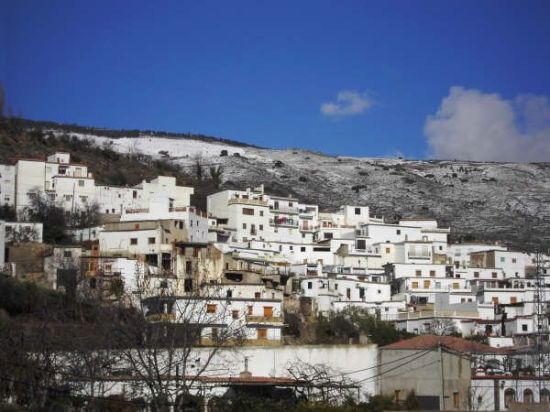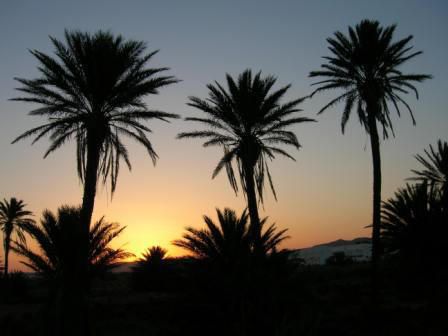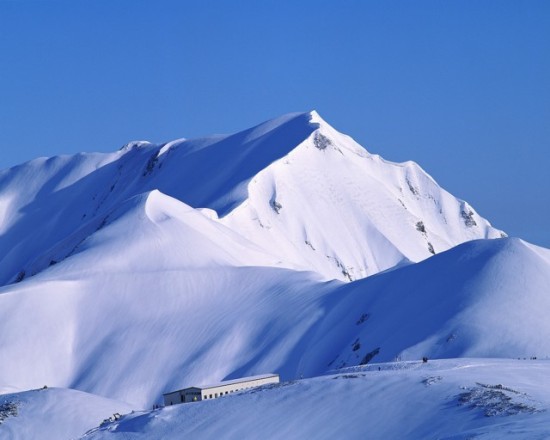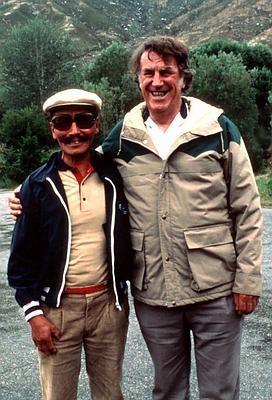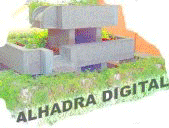La energía del sol
19 febrero 2008 a las 21:05 | Publicado en Tecnología | Deja un comentarioA mi, particularmente, hay noticias que me gustan porque me producen la sensación de que este mundo nuestro con sus crisis y sus problemas, puede mejorar.
Por un lado están las noticias que tienen que ver con la actuaciónes de personas que desinteresadamente ayudan a los necesitados aquí o en el tercer mundo. Son actitudes personales que van mas ayá de lo que pueda ser un religión o una ideología. Es un compromiso con los demás que manifiesta una sentimiento sincero de humanidad.

Tambien me gusta pensar que los adelantos tecnológicos que tanto están modificando nuestra sociedad pueden ayudar a resolver los problemas que la misma tecnología ha creado y que son muchos. Es una confianza ciega en que un uso inteligente de la tecnología puede ayudar al hombre, mas que perjudicarlo.
Sobre este último tipo de noticias voy a comentaros tres ejemplos de adelantos que a mi me parecen interesantes.
Por un lado necesitamos energías renovables , y ahí está el Sol. Tambien se buscan unos sistemas eficaces de almacenamiento y, en esa linea tenemos las pilas de hidrogeno. Por último, tenemos que ahorrar materiales, como por ejemplo papel y tinta y por ello hablaremos de la tinta y libros electrónicos.
Avances en energías alternativas: energía fotovoltaica
 La energía fotovoltaica está de moda en el planeta. Las placas solares están constituidas por celulas fotovoltaicas que pueden transformar directamente la energía solar en electricidad. Una compañía estadounidense de California, fundada con capital de los creadores de Google, avanzó que construirá la central de células solares más grande del mundo en la bahía de San Francisco.
La energía fotovoltaica está de moda en el planeta. Las placas solares están constituidas por celulas fotovoltaicas que pueden transformar directamente la energía solar en electricidad. Una compañía estadounidense de California, fundada con capital de los creadores de Google, avanzó que construirá la central de células solares más grande del mundo en la bahía de San Francisco.
Las obleas que fabrica esta empresa son de película delgada y no contienen silicio, el principal semiconductor empleado en la fabricación de células y cuya carestía está impidiendo el crecimiento potencial de la industria fotovoltaica.
 La firma estadounidense asegura que sus células, desarrolladas en los últimos cuatro años en laboratorio, son tan eficientes como las de silicio pero con un precio de producción un quinto más bajo. Este tipo de células se imprimen sobre plástico flexible con una aleación de cobre.
La firma estadounidense asegura que sus células, desarrolladas en los últimos cuatro años en laboratorio, son tan eficientes como las de silicio pero con un precio de producción un quinto más bajo. Este tipo de células se imprimen sobre plástico flexible con una aleación de cobre.
Estos recubrimientos son tan delgadas como una capa de pintura y puede transferir la energía de la luz con eficiencia asombrosa.
Otros investigadores estudian aumentar el rendimiento de estas celulas concentrando por distintos metodos la energía solar que reciben. En España y en Almería ya tenemos funcionado huertos solares. Zonas junto a los pueblos o ciudades donde se instalan los paneles solares y que puede producir electricidad para abastecer a muchos hogares. El ejemplo lo tenemos en Lucainena de las Torres (Almería) donde se ha instalado una planta solar que abastecerá de electricidad a 180 hogares.

El papel y la tinta electrónica
19 febrero 2008 a las 21:04 | Publicado en Tecnología | 2 comentariosEs curioso lo que está ocurriendo con los libros y los periódicos en papel. Mientras que la música, el video, etc. se están pasando integramente al soporte digital, no ha ocurrido así con los los libros, periódicos y manuales que siguen leyendose mayoritariamente en el soporte tradicional de papel. ¿Cual es la razón de que esto sea así y para cuando será la revolución de lo libros digitales?
 La mayor parte de los lectores considera que el atractivo del libro se debe a que se ojea, se transporta y se lee con mas comodidad. Efectivamente, no existe todavia a nivel comercial una buen soporte para los libros o los periódicos. Los ordenadores portátiles, con su pantalla tft, cansan la vista, y no se ve bien a plena luz del día, además de que su bateria tiene poca duración y los hace pesados e incomodos.
La mayor parte de los lectores considera que el atractivo del libro se debe a que se ojea, se transporta y se lee con mas comodidad. Efectivamente, no existe todavia a nivel comercial una buen soporte para los libros o los periódicos. Los ordenadores portátiles, con su pantalla tft, cansan la vista, y no se ve bien a plena luz del día, además de que su bateria tiene poca duración y los hace pesados e incomodos.
Esto puede cambiar en poco tiempo gracias a la tecnología de la tinta y el papel electrónico.
En este enlace se explica como funciona este sistema
 Ventajas que tiene el sistema: poco peso, poco consumo, nitidez a plena luz del día, y sobre todo que se pueden crear laminas finas y hasta plegables. Todas las aplicacines en que se usa el papel podrían ser sustituidas por este sistema. Libros, carteles, periódicos, rótulos de precios de productos en los supermercados, etc.
Ventajas que tiene el sistema: poco peso, poco consumo, nitidez a plena luz del día, y sobre todo que se pueden crear laminas finas y hasta plegables. Todas las aplicacines en que se usa el papel podrían ser sustituidas por este sistema. Libros, carteles, periódicos, rótulos de precios de productos en los supermercados, etc.
Ya hay marcas como Sony y Amazon que han creado aparatos ligeros que sirven para leer libros que están en su memoria y que se pueden descargar de Internet. El vídeo siguiente muestra como puede ser el futuro inmediato.
Si se abarataran estos dispositivos, podría ser la solución para disminuir el consumo de papel y el costo de los libros. Tambien podría servir para que nuestro alumnos no tuvieran que transportar tanto peso. Con solo el lector de no mas de 300 g tendrían todos los libros (mas de 100) y todos los documentos que les quisiermos aportar. No creais que esto es raro. El gobierno de Holanda se está planteando dotar a todos los alumnnos de secundaria con esto cacharros. Los veremos pronto. Seguro.
Mystery
15 febrero 2008 a las 18:40 | Publicado en General | 2 comentariosThe Mystery of Number Eleven
By IVÁN GARCÍA. 3ºE.S.O.-A
This is a curious e-mail a friend´s of mine received:
isn’t it incredible? . Is It a coincidence?
1) “ New York City” has got eleven letters
2) “ Afghanistan” has got eleven letters
3) “ Ramsin Yuseb” (the terrorist that threatened with destroying the World Trade Center in 1993) has got eleven letters
4) “George W. Bush” has got eleven letters.
This can be a coincidence, but now comes the most interesting:
5) New York is the state number eleven
6) The first flight that crashed against the Twin Towers was the number eleven
7) In the flight number eleven there were ninety-two passengers on board: 9+2=11
8) The flight number seventy-seven crashed with the Trade World Center too, there were sixty-five passengers on board: 6+5=11
9) The tragedy happened on the eleventh of September or better 9/11: 9+1+1=11
10) The day is the same as the emergencies phone number in the USA (911) 9+1+1=11
Coincidence ? Continue reading and tell me then
11) The total number of victims in the planes were two hundred fifty-four : 2+5+4=11
12) The explosions in Madrid were on the day 3/11/2004 3+1+1+2+4=11
13) The tragedy of Madrid took place nine hundred eleven days after the incident of the Trade World Center 9+1+1=11
Now open the Microsoft Word and do this:
- Write in capital letter Q33 NY this is the first flight number that crashed with the Trade World Center
- Shade the Q33 NY
- Change the size to 48
- Change the letter to WINGDINGS and
now…
What do you think?…
Literature
15 febrero 2008 a las 10:21 | Publicado en General | 3 comentariosGERALD BRENAN:
In Love with Spain
By Javier Carrasco
Gerald Brenan (1894-1987) was an English writer and Hispanist who lived most of his life in Andalucía. He was born in Malta while his father was serving in the British Army, and educated at Radley, a boarding school in England where he suffered from bullying. Travel and adventure were to be his way of life and at the age of sixteen he ran away from home with an older friend to walk to China. Between August 1912 and January 1913 they walked 1,560 miles but the outbreak of the Balkan War and shortage of money caused him to return to England. During the World War I he served in France. After the war he was introduced to the so-called Bloomsbury Group, the literary greats of the period, namely, Leonard and Virginia Woolf, Lytton Strachey and other famous English writers. But he hated the hypocrisies of British bourgeois society and decided to leave the country in search of Mediterranean life. Low living costs and a relaxed way of life was all he needed.
Thus, he came to Spain in 1919 for the first time and settled in Yegen (Granada), a little village in Las Alpujarras, not far from Láujar de Andarax (Almería). His most famous books are The Spanish Labyrinth, (1943) about the Spanish Civil War, and of special interest for us South From Granada, (1957) where two chapters refer to Almería. During the Civil War he returned to England. In 1953 he was allowed to come back to Spain besides he opposed Franco’s regime. He spent most of the remainder of his life in Alhaurín el Grande (Málaga). He received the great American writer Ernest Hemingway as his guest there.
South From Granada is a book which mixes ethnography and travel narrative. Gerald Brenan describes customs of Las Alpujarras, its natural history, its history and his personal experiences there. He also dedicates some chapters to the cities of Granada and Almería in the 1920’s.
As regards the two chapters devoted to Almería, the first one, titled ‘Almería and its brothels’ (houses of prostitutes) describes the time when Brenan had to travel to Almería to buy some furniture and wait for a letter with the money he had asked his uncle. At the beginning he gives a poetical description of the city: ‘Almería is like a bucket of whitewash thrown down at the foot of a bare, greyish mountain. A small oasis –the delta of the River Andarax- spreads away beyond it’. Then he narrates ‘an adventure that happened to me’. He met a man called Agustin Pardo, a broker who told Brenan his life was completely ruined by vice. This character is presented as a very boastful man, in fact later Brenan finds out he is a liar. Then Agustín proposed to visit some brothels in the town. First Brenan hesitates: ‘I could not do so because I was not attracted by prostitutes’, but, eventually he accepts the invitation on the grounds that ‘for a man of culture and education such as myself, it would be instructive’. The tour becomes a useful tool for Brenan to learn about society in Almería at that time. People seemed cursed with poverty, disease and illiteracy. The atmosphere reminds that one found in the book La Chanca written by the Spanish writer Juan Goytisolo some years later (1962). In the end his uncle’s letter arrived saying that he would not send him any money and, consequently, Brenan had to face a financial shortage once again.
The other chapter is called ‘Almería and Archaeology’. The writer begins telling us that his visits to Almería produce a feeling of excitement on him, more than visiting Granada: ‘Certainly, it seemed that the sea was doubly Mediterranean here, and the city…contained within it echoes of distant civilizations’. Then he describes Almería in the Middle Ages, in times of Abd-elRahman III, in the 10th and 11th centuries, when the city controlled the merchant routs in the Western Mediterranean Sea. He also mentions his meeting with the Belgian engineer Louis Siret, also a famous archaeologist, who made surprising discoveries in the areas of Los Millares and El Argar from the Copper and Bronze Ages respectively. Moreover, Brenan speaks about natural history, including botany and mineralogy in the region.
Just to finish let’s take a look on his description of Cabo de Gata: ‘About a dozen miles to the south of Níjar is the Cabo de Gata…its name is really a corruption of Cabo de Ágata, Cape Agate. Its red, waterless rocks are volcanic, and since Phoenician times have been famous for their supply of various sorts of precious and semi-precious stones. On the seashore a little to the west of that cape, at a place known as Torre García, there is a small chapel which marks the spot where the Virgen del Mar, who is the patroness of Almería, appeared to some sailors in the year 1502 and showed them where her image lay buried in the sand dunes’. In short, South From Granada, is an interesting and amusing book we all should keep in our bookcases.
Climbing
15 febrero 2008 a las 10:16 | Publicado en Botijo, Febrero2008 | Deja un comentarioE. HILLARY
A GREAT PIONEER
A STEP INTO HISTORY
A GREAT PERSON
By Juan Avilés. 3ºESO-A
Edmund Hillary has died in Auckland (New Zealand). He was the first person to climb Everest along with his partner Tenzing Norgay from Nepal.
He was born in New Zealand on July 20th 1919 and reached* the top of Everest on May 29th 1953 at the age of 33. In 1951 he was told that two of his climbing team would be invited to Nepal for the Everest expedition. Intelligently, he realized* that the leader of the expedition, Eric Shipton would choose two people from different nationalities and his partner Lowe was also from New Zealand. He discreetly* changed partners and partnered up* with Tenzing. Tenzing was a Nepalese Sherpa. Sherpas live near Everest and they are used to living in the mountainside* so maybe, because of that he was chosen. Nowadays* many people climb Everest without oxygen but back then they wore far more clothing and looking at modern mountaineers’ equipment would have thought it belonged to a museum. Three days prior* to Hillary’s ascension another team tried to climb Everest but only Edmund and Tenzing did it. Why?Well, that’s because they had more reliable oxygen set, they started from a much higher camp and they faced better conditions. However the journey was difficult and they only could climb the mountain thanks to Hillary who had a technical mind and great insight* into the mountain and its terrain.
Sir E. Hillary & Tenzing Norgay
Hillary’s personality may have contributed to his success. He was selfless, paid attention to detail, confident* with a cussed* determination and was highly intelligent. Along with these qualities he may have had a small stroke* of luck. The only one “bad” thing was his distant friendship from Lowe because Lowe wasn’t chosen for the expedition. It is well reported*that he wasn’t a cynical manipulator at all, in fact* he was a very humble* person as he didn’t tell the media* or the villagers in Nepal that he was the first to reach the summit until Tenzing died. Most climbers proudly tell people who of the two within a team gets to the top first. For these great achievements he will be remembered forever as the pioneer of Everest.
THE LITTLE DICTIONARY
Reach: alcanzar
Realize: darse cuenta
Discreetly: inesperadamente
Partner up: emparejar, asociar
Mountainside: falda de una montaña
Nowadays: hoy en día
Prior: antes, previo
Insight: perspicacia, idea, entendimiento
Confident: seguro
Cussed: terco, cabezón
Stroke: racha
Friendship: amistad, relación de amistad
In fact: de hecho
Humble: humilde
Media: medios de comunicación
Summit: cima (de una montaña)
Achievement: proeza
Report: noticia, informar
Nosotros los jóvenes
14 febrero 2008 a las 23:44 | Publicado en General | 2 comentarios
No quiero decir que debamos estar todos los días haciendo manifestaciones. Pero sí podemos protestar, hacer que se escuche nuestra voz. Debemos demostrar que nos importa el mundo en que vivimos, que rechazamos lo que no nos gusta.
Nos aplicamos el calificativo de rebeldes: pero ¿por qué? ¿ Porque en los años 60 y 70 todos los jóvenes hicieron que su voz se oyera? Mucha gente dice que en esos años los de nuestra edad tenían una motivación para actuar de esta forma. ¿Ahora no la tenemos? Yo creo que sí, y muchas. Está la guerra de Yugoslavia. ¿Por qué los gobiernos no se implican como en la guerra del Golfo? ¿Nunca os habéis parado a pensarlo? Yo, sí. En el Golfo había dinero y en Yugoslavia sólo vidas.
Así que aquí tenemos motivaciones. Y sin alejarnos de Almería. Tenemos un problema: la legión. Se decidió instalarla aquí y así se hizo. Nadie protestó. Otra vez se muestra la cara apática de Almería. Nos limitamos sólo a hacer cuatro pintadas en una pared y con eso creemos que nuestra conciencia queda libre de culpas.
Creo que debemos demostrar que nos importa lo que sucede a nuestro alrededor. Debemos concienciarnos, que no nos manipulen y que se escuche nuestra voz y nuestra opinión. Que nos tomen en serio. Nosotros somos parte del mundo y en el futuro tendremos la responsabilidad que ahora atañe a nuestros padres. Algún día el mundo dependerá de los que ahora somos jóvenes. ¡Actúa!
PRESEN ROQUE GIL
Febrero 1994
Blog de WordPress.com.
Entries y comentarios feeds.





